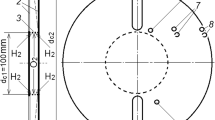Abstract
A closed mathematical model of continuous spin detonation with the chemical kinetics equation correlated with the second law of thermodynamics is developed for a hydrogen–air mixture within the framework of the quasi-three-dimensional unsteady gas-dynamic formulation. The model takes into account the reverse influence of the oscillation processes in the combustor on the injection system of the mixture components. For comparisons with experimental data, the numerical simulations are performed for the geometric parameters of the flow-type annular combustor with an outer diameter of 306 mm used in the experiments. For the flow rates of the mixture varied in the interval 73.1–171.3 kg/(s\(\, \cdot\,\)m\(^{2}\)), the one-wave, two-wave, and three-wave regimes of continuous spin detonation are calculated, the flow structure is analyzed, the specific impulses are determined, and comparisons with experimental data are performed. It is shown that the use of a simplified single-stage kinetic scheme of hydrogen oxidation, which was used in some investigations, for simulating continuous spin detonation leads to results that differ from the experimental data by several times.








Similar content being viewed by others
REFERENCES
B. V. Voitsekhovskii, “Steady Detonation," Dokl. Akad. Nauk SSSR 129 (6), 1254–1256 (1959).
F. A. Bykovskii, S. A. Zhdan, and E. F. Vedernikov, “Continuous Spin Detonations," J. Propuls. Power 22 (6), 1204–1216 (2006).
F. A. Bykovskii and S. A. Zhdan, Continuous Spin Detonation (Izd. SO RAN, Novosibirsk, 2013) [in Russian].
F. A. Bykovskii, S. A. Zhdan, and E. F. Vedernikov, “Spin Detonation of a Fuel–Air Mixture in a Cylindrical Combustor,"Dokl. Akad. Nauk, 400 (3), 338–340 (2005).
F. A. Bykovskii, S. A. Zhdan, and E. F. Vedernikov, “Continuous Spin Detonation in Fuel–Air Mixtures," Fiz. Goreniya Vzryva42 (4), 107–115 (2006) [Combust., Expl., Shock Waves42 (4), 463–471 (2006).
F. A. Bykovskii, S. A. Zhdan, and E. F. Vedernikov, “Continuous Spin Detonation of a Hydrogen–Air Mixture with Addition of Air into the Products and the Mixing Region," Fiz. Goreniya Vzryva46 (1), 60–68 (2010) [Combust., Expl., Shock Waves46 (1), 52–59 (2010)].
S. A. Zhdan, F. A. Bykovskii, and E. F. Vedernikov, “Mathematical Modeling of a Rotating Detonation Wave in a Hydrogen–Oxygen Mixture," Fiz. Goreniya Vzryva 43 (4), 90–101 (2007) [Combust., Expl., Shock Waves 43 (4), 449–459 (2007)].
M. Hishida, T. Fujiwara, and P. Wolanski, “Fundamentals of Rotating Detonations," Shock Waves 19 (1), 1–10 (2009).
D. Schwer and K. Kailasanath, “Fluid Dynamics of Rotating Detonation Engines with Hydrogen and Hydrocarbon Fuels," Proc. Combust. Inst. 34, 1991–1998 (2013).
R. Zhou, D. Wu, and J. Wang, “Progress of Continuously Rotating Detonation Engines," Chin. J. Aeronaut. 29 (1), 15–29 (2016).
A. V. Dubrovskii, V. S. Ivanov, and S. M. Frolov, “Three-Dimensional Numerical Simulation of Continuous Detonation of a Hydrogen–Air Mixture in an Annular Combustor," Gorenie Vzryv5 (5), 145–150 (2012).
S. M. Frolov, A. V. Dubrovskii, and V. S. Ivanov, “Three-Dimensional Numerical Simulation of the Working Process in a Combustor with Continuous Detonation with Separate Injection of the Fuel and Oxidizer," Khim. Fiz. 32 (2), 56–65 (2013).
Yu. A. Nikolaev and D. V. Zak, “Agreement of Models of Chemical Reactions in Gases with the Second Law of Thermodynamics," Fiz. Goreniya Vzryva 24 (4), 87–90 (1988) [Combust., Expl., Shock Waves 24 (4), 461–464 (1988)].
V. A. Levin and V. P. Korobeinikov, “Strong Explosion in a Combustible Mixture of Gases," Izv. Akad. Nauk SSSR, Mekh. Zhidk. Gaza, No. 6, 48–51 (1969).
R. A. Strehlow, A. J. Crooker, and R. E. Cussey, “Detonation Initiation Behind an Accelerating Shock Wave," Combust. Flame11 (4), 339–351 (1967).
E. S. Prokhorov, “Approximate Model for Analysis of Equilibrium Flows of Chemically Reacting Gases," Fiz. Goreniya Vzryva32 (3), 77–85 (1996) [Combust., Expl., Shock Waves32 (3), 306–312 (1996)].
S. K. Godunov, A. V. Zabrodin, M. Ya. Ivanov, et al.,Numerical Solution of Multidimensional Problems of Gas Dynamics (Nauka, Moscow, 1976).
Yu. A. Nikolaev and M. E. Topchiyan, “Analysis of Equilibrium Flows in Detonation Waves in Gases," Fiz. Goreniya Vzryva13 (3), 393–404 (1977) [Combust., Expl., Shock Waves13 (3), 327–337 (1977)].
V. P. Kolgan, “Application of the Principle of the Minimum Values of the Derivative to Constructing Finite Difference Schemes for Computing Discontinuous Solutions of Gas Dynamics," Uch. Zap. TsAGI 3 (6), 68–77 (1972).
Author information
Authors and Affiliations
Corresponding author
Rights and permissions
About this article
Cite this article
Zhdan, S.A., ARybnikov, A.I. & Simonov, E.V. Modeling of Continuous Spin Detonation of a Hydrogen–Air Mixture in an Annular Cylindrical Combustor. Combust Explos Shock Waves 56, 209–219 (2020). https://doi.org/10.1134/S0010508220020124
Received:
Published:
Issue Date:
DOI: https://doi.org/10.1134/S0010508220020124



